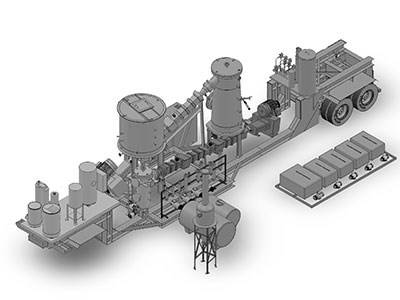A northwestern Ontario pulp mill will be a test site for a prototype technology designed to extract and separate sugars from wood and improve fibre recoveries.
The Thunder Bay-based Centre for Research and Innovation in the Bio-Economy (CRIBE) is investing $1.3 million as part of a partnership deal with Greenfield Specialty Alcohols for a demonstration project at the AV Terrace Bay mill this year.
Greenfield is matching CRIBE’s investment as part of this $2.7-million project.
The Toronto-based ethanol producer has a patent-pending technology that can extract “clean sugars” from wood fibre that can be applied to make high-end bio-products.
Called a modified twin screw extruder, a mobile version will be bolted on a flatbed truck and taken to the mill, which is being converted by the Aditya Birla Group of India from a conventional pulp mill into a dissolving pulp process.
“What better place to get those sugar streams than a dissolved pulp mill?” said CRIBE CEO Lorne Morrow.
GreenField’s technology can be used at both the front and back end of the pulping process.
They’ve developed a pre-treatment method of cooking wood fibre where the C5 and C6 sugar streams are siphoned off and separated into pure streams.
These streams -- a combination of lignin and hemicellulose -- are normally used as black liquor, a by-product that’s used as an alternative fuel.
Morrow said chemistry researchers prefer these sugar streams as bio-based platforms to make glues, phenols (used for disinfectants), xylitols (used for artificial sweeteners) and other chemicals.
On the backside of the plant process, the same technology can be applied to treat pulp sludge and white water to recover residual wood fibre.
Morrow said if this process were eventually commercialized, it would also represent a savings on disposal for forest product companies.
As the former manager of the Norampac mill in Red Rock, Morrow estimated about 15 to 20 tonnes of unrecovered fibre residue from his operation’s white water waste stream would be trucked off to the landfill on a daily basis.
One of the technology’s inventors is former Tembec founder Frank Dottori.
He’s the chairman of both CRIBE and the AV Terrace Bay, and is also the head of GreenField’s cellulosic ethanol division.
“Dottori is no fool,” said Morrow. “If he can improve his recovery at a pulp mill, that’s a big gain.”
CRIBE is a not-for-profit created by the provincial government in 2009, when the forestry industry was hitting rock bottom and about 80 per cent of the mills in northwestern Ontario were being wiped out.
Its purpose was to form partnerships and provide funding for a new wave of value-added forest products.
CRIBE previously wrote a $3-million cheque to GreenField in 2011 to develop its $42-million corn-to-ethanol demonstration plant in Chatham.
Part of the deal was matching up GreenField’s research group with Lakehead University’s Biorefining Research Institute to give them a chance to grow.
“They took this proof of concept and began to pre-treat wood fibre,” said Morrow. “It’s a true success story and it’s coming from the downstream (players), not the upstream.”
Still, the industry’s willingness to invest in the R & D of new wave forest products remains rather tepid, but Morrow said that’s understandable.
He said it would have been totally unrealistic in 2009 to expect CRIBE to start rolling out a new catalogue of bioproducts when companies were in full survival mode.
Even now, many are attempting to build up cash flow while struggling with sky-high power rates and fibre costs that remain high because of fuel prices.
But what pleases Morrow is how companies and organizations like Resolute Forest Products, FP Innovations and Confederation College have collaborated on various other projects with CRIBE funding.
“We have a bit of cluster forming here,” said Morrow. “In Northern Ontario, you’ve got 10 to 15 highly qualified people working on this field. Five years ago that wasn’t there.”
CRIBE also provided up to $1.5 million to leverage up to $4 million to increase production capacity at Ensyn Technologies’ Renfrew biofuel plant in eastern Ontario.
Ensyn has a petroleum-replacement liquid biofuel produced from forest residues for heating oil customers in Quebec and the northeastern United States.
The staff of 14 is expected to double as the plant is brought up to full production capacity from three million litres to 13 million litres annually.
Ensyn’s trademarked RFO liquid biofuel is based on the conversion of wood and other non-food, cellulosic biomass to advanced cellulosic biofuels. It’s used for heating fuel and is also a feedstock for refineries in the production of gasoline and diesel.
Ensyn signed a five year contract with Memorial Hospital of North Conway, New Hampshire for the supply of RFO for heating purposes, replacing petroleum-based fuels.
“This strategic investment by CRIBE not only supports the future of Ensyn’s Renfrew RTP facility but also supports wood-based forest industries in the area through the increased use of forest residue at the Renfrew facility,” said Lorne Morrow, CRIBE’s CEO.




